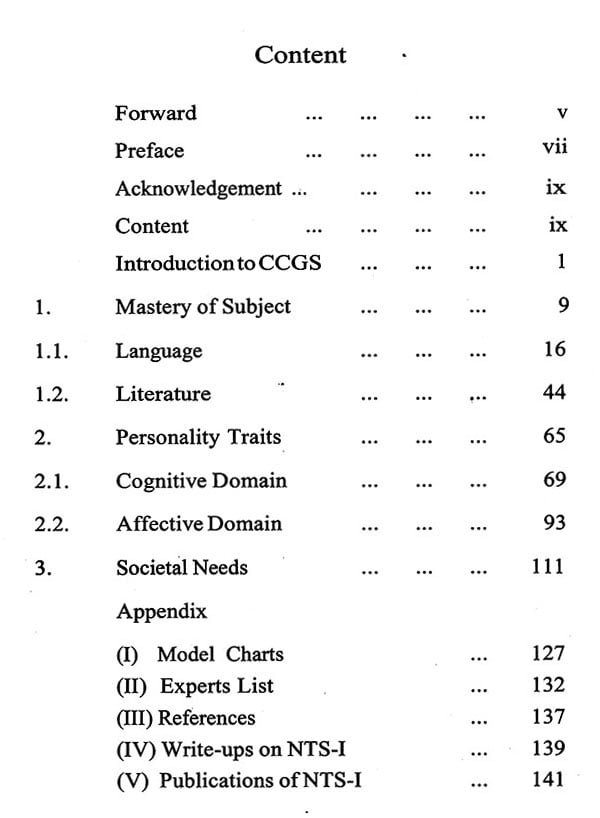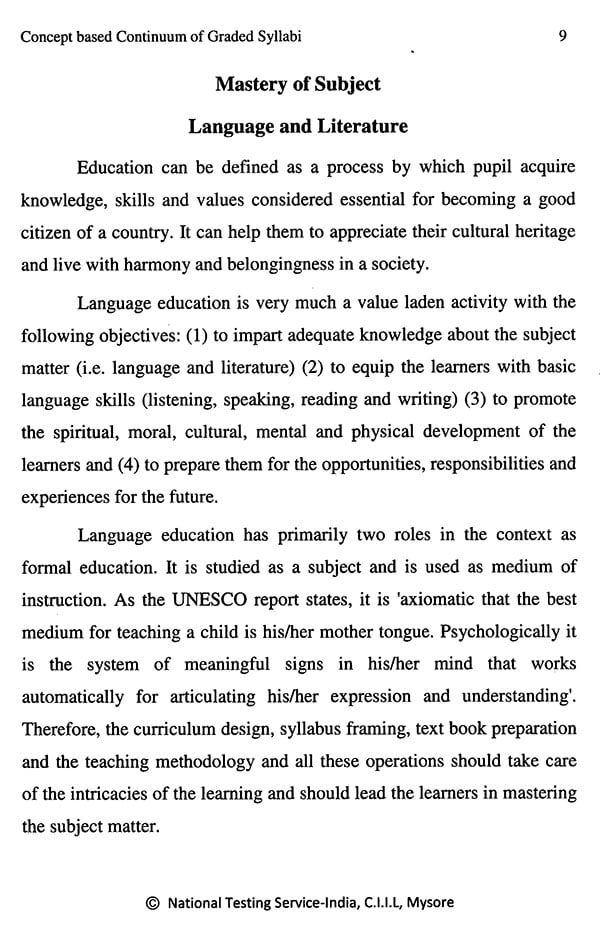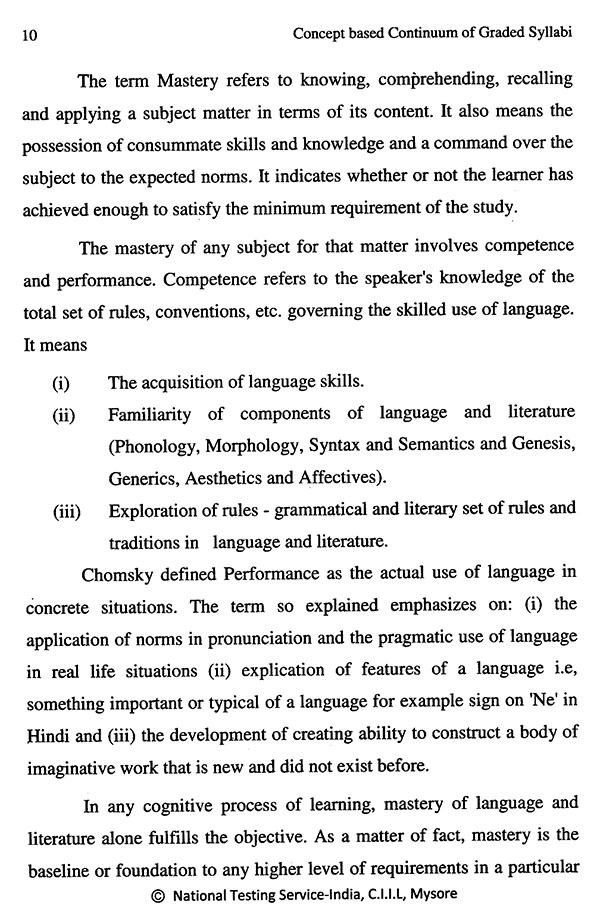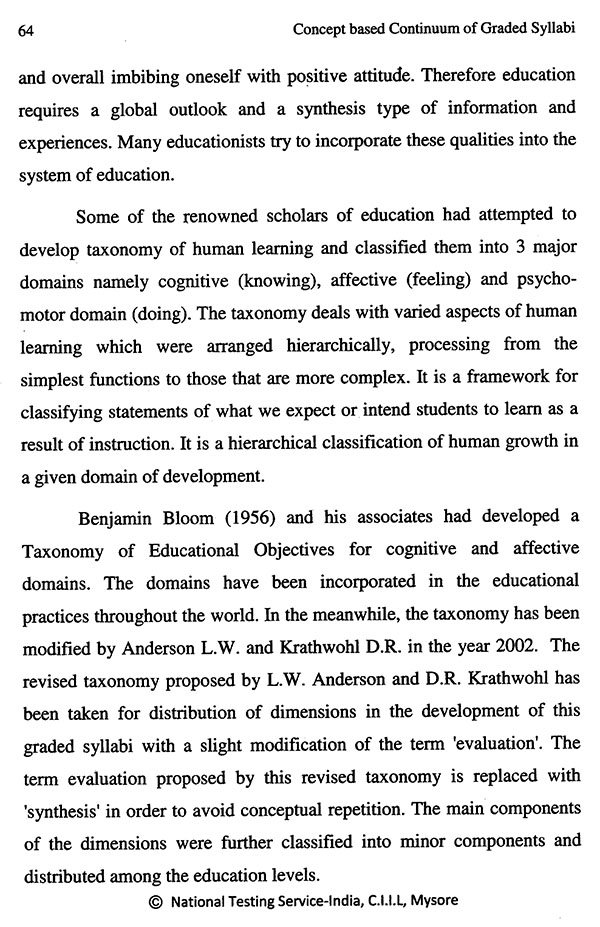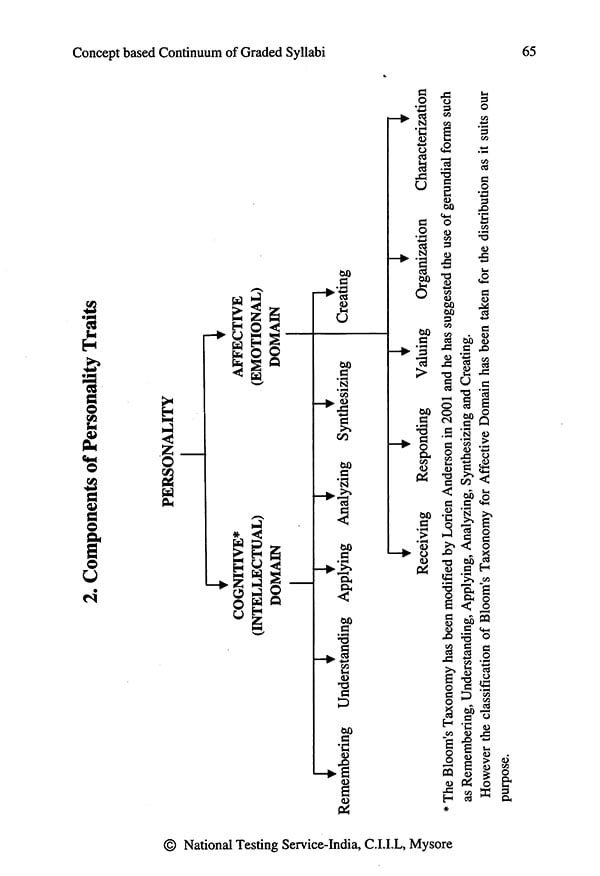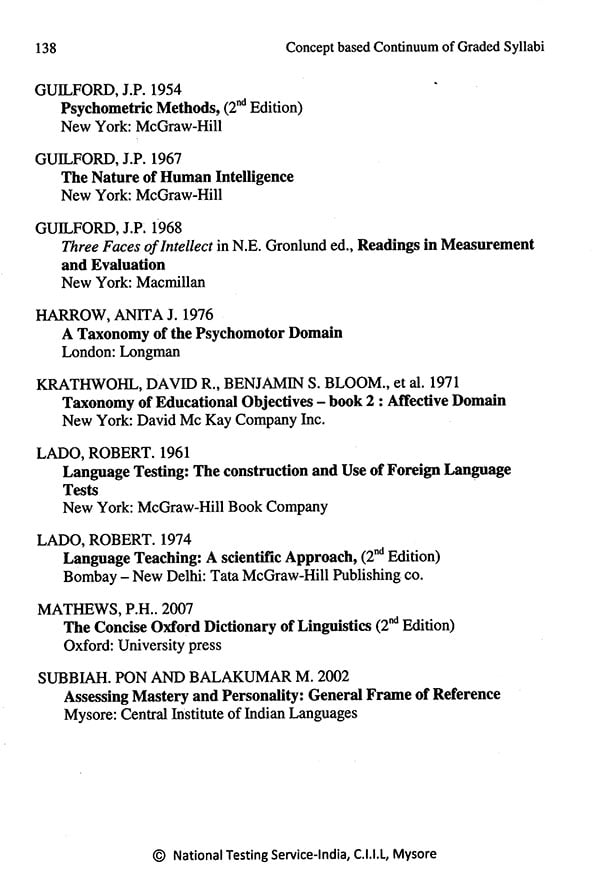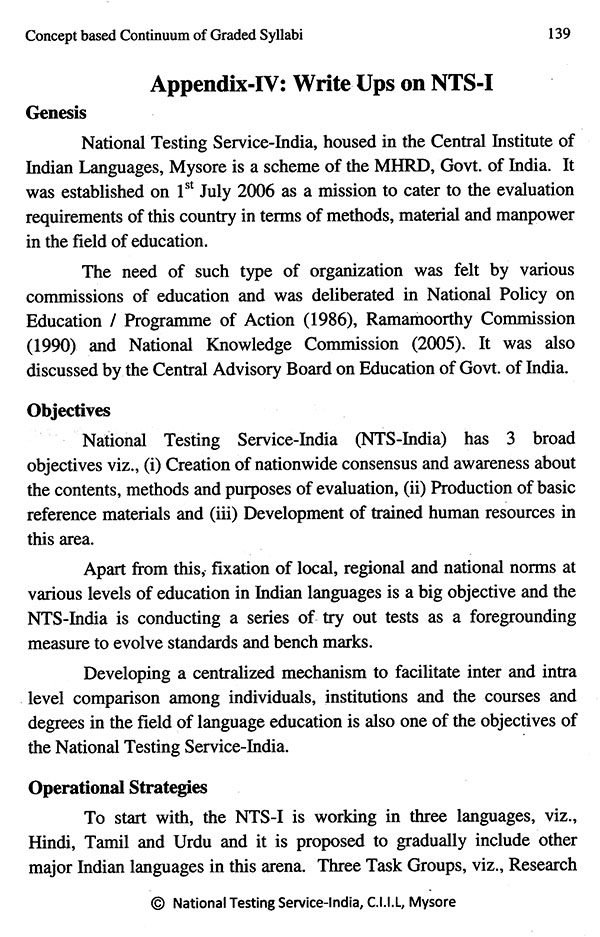
Concept Based Continuum of Grade Syllabi (CCGS)
Book Specification
| Item Code: | NAX390 |
| Author: | Pankaj Dwivedi |
| Publisher: | Central Institute Of Indian Languages, Mysore |
| Language: | English |
| Edition: | 2016 |
| ISBN: | 9788173431715 |
| Pages: | 152 |
| Cover: | PAPERBACK |
| Other Details | 10.00 X 7.00 inch |
| Weight | 320 gm |
Book Description
The Central Institute of Indian Languages, Mysuru (CIIL, Mysuru) has been set up with a view to assist and coordinates the development of Indian languages along all possible dimensions. It is also assigned with the responsibility of serving as a nucleus to bring together all the research and literacy output from the various linguistic streams to a common head and to narrow the gap between the basic research and application based research in the field of languages and linguistics in India. To fulfill this responsibility, the CIIL has established various research centres to undertake the academic activities in the areas of language / linguistics.
Accordingly Centre for Testing and Evaluation (CT&E), a unit of CIIL, Mysuru has been working in the area of testing and evaluation from as early as 1984. As a result CIIL has been given the responsibility of establishing National Testing Service-India (NTS-I) by the Ministry of Human Resource Development of Government of India. NTS-I has made an earmmest attempt to prepare not only the basic reference materials in the area of Language Testing and Evaluation but also to provide trained human resource in the field. Over the period of more than last two decades, centre has produced and published more than 50 volumes of materials in English and various other Indian languages under different series such as Glossary of Evaluation Terms, Introduction to Evaluation Terminologies, Tests of Language Proficiency, Concept Based Continuum of Graded Syllabi (CCGS), etc. for the seven levels of education.
The draft version of CCGS has been developed (initially in English) on the basis of the General Frame of Reference (GFR) in language, literature and personality to meet various requirements of evaluation. It consists of major, minor and sub components of language, literature, personality growth and societal needs. These items are duly arranged and presented in a hierarchical order and distributed across the seven levels of general education so that they could serve as the units of teaching as well as testing.
As the CCGS is meant for all the seven levels of general education and the concepts involved are drawn from different disciplines, it stresses consensus among experts regarding the appropriateness in their adaptability, suitability, and arrangement in sequence according to the difficulty levels. In view of this, the need arises for the linguists, educationists, psychologists and other specialists to play a decisive and crucial role in achieving this academic milestone.
This challenging task has been accomplished mainly because of the relentless efforts of the academic and administrative staff members of the Centre for Testing and Evaluation. I am sure this will be a valuable resource book for all the stake-holders of education especially for those involved in the language education and will serve the purpose for which it has been prepared.
The National Testing Service-India has been established in 2006 as a central scheme of Ministry of Human Resource and Development (MHRD) at Central Institute of Indian Languages of the CIIL to cater to the pedagogical needs of scientific and systematic teaching, learning and testing at different levels of education. It has three primary objectives viz., (1) to create of nationwide consensus and awareness about concrete methods and purposes of evaluation (2) to produce of basic reference material and (3) to develop trained human resources in this area.
In this connection, the National Testing Service-India (NTS-I) is not only preparing conceptual explanation of evaluation terms in Indian languages but also developing scales for determining the language competence of an individual at different levels of education. This endeavor is not withstanding the stray efforts made by various policy making bodies related to school or university level of education. Besides these, the NTS has been involved in drafting a Concept Based Continuum of Graded Syllabi (CCGS) applicable to all the seven levels of general education, to start with for the language discipline before extending the same to other disciplines later.
In order to render the CCGS a comprehensive venture, the syllabi of language and literature courses being followed at various levels of education under different systems have been examined in an elaborate manner with a focus on the common concepts. Subsequently, these concepts have been demarcated and distributed across the seven levels of general education. It is believed that the CCGS would serve as a common base there by paving a way for establishing inter language comparability at the national level (e.g. MA in Tamil vs. MA in Hindi) and intra language comparability at the regional level (e.g. MA Urdu of Aligarh Muslim University vs. MA Urdu of Hyderabad Central University). Consequently, any language learner of the country can compare and decide whether his/her competence is on par with, or above or below the national or regional norms.
The CCGS has been depicted through the form of a table consisting of three main columns of which the first one consists of the structural elements that constitute the concept of language / literature (presented in a supposedly hierarchical order) and including the details of scope (dimensions) that are associated with each one of the structural elements, the constituent elements and the dimensions common to all the languages. The second main column (divided into two sub-divisions) comprises the corresponding details of consequential effect in the all round growth of a person, as enumerated by various taxonomies of education (these details are intended to be the common outputs of learning irrespective of the discipline of study). The third main column deals with the societal needs which are essential for the development of a society. The purpose of the whole exercise is meant to help create a system with clearly demarcated teaching and testing units in a graded manner so that the process of quantification, measurement, and evaluation becomes meaningful, relevant, and valid at every level of education.
Education is a purposive activity with clear goals, values and objectives which are inherent in the components of education viz., aims, educational process, curriculum, syllabus, method and teacher-learner relations. Education deals with knowledge and aims at imparting knowledge. It requires a global outlook, various types of information and experiences as the aim of education which is the "enhancement or enrichment of personality, the differentiating feature of which is the embodiment of universal values" (R. Rusk Robert).
Curriculum refers primarily to the various activities and includes not only what pupils learn, but also how they learn and how teachers help them learn, using what materials, styles of teaching and methods of assessment and in what kind of facilities and so on. In the broadest sense, it includes all the relevant decision making processes of all the stakeholders. It is an attempt to fix and achieve certain ends for the benefit of the students. It encompasses more than just a course of study. It embodies the following elements in particular:
Syllabus refers to the details of the subject prescribed in a course of study. In other words, it is a brief description of the main points of a course of study with the list of topics, books, etc. indicated that student should study in a particular subject. It is a delineation of the outline or statement of the main points of a course of study. Thus, any syllabus is an important document which is supposed to provide necessary information / guidelines to all those who are involved in the educational process, viz., teachers, learners, evaluators and administrators.
Syllabi are framed based on a curriculum that is a body of knowledge to be transmitted through the teaching-learning process. The CT&E and NTS-I of CIIL has made an attempt to develop graded syllabi for all the seven levels of education covering Primary to Research levels. Gradation is a systemic process of arranging something in the order of merits. It may be done by adopting the principles of known to unknown, simple to complex or concrete to abstract. It is a process of a hierarchical classification of human growth in a subject of study of given domain for development.
The Concept based Continuum of Graded Syllabi (CCGS) for language, literature, personality growth and societal needs is devoted to offering conceptual explanations with an eye on improving the quality of teaching and testing operations in our educational contexts. It is content free in the sense that in this document no subject matter is prescribed for teaching. Instead concepts are proposed to be taught. For example, in place of prescribing that at primary level nouns should be taught; it is indicated that at primary level noun ‘forms' may be taught. In this respect it has been stipulated as concept based.
It assumes a continuum as it is arranged in a series of continuous progression or development encompassing concepts of the subject to be its consequential effect or components of learner's growth and the fulfillment of the societal needs at every level of the educational process.
It is graded because its components are spread over the seven levels of general education i.e. from primary to research level.
The personality development is one of the expectations of the education. The incorporation of values in the learning material contributes significantly in the development of a pupil. The developmental process of personality involves giving knowledge and confidence, learning etiquettes, manners / behaviours etc. Accordingly the personality traits contributing to the personality of a person systematically incorporated in the distribution.
The CCGS is an overall framework devised by NTS-India to serve aS source material or a model perspective developed for the stake- holders of language education, especially for those involved in the formulation of courses of study, preparation of text books or any such teaching-learning material and engaged in the testing and evaluation processes. It is a suggested rubric by which the linguistic and literary contents, vocabulary, grammar, notions, functions and values and other important aspects are identified, selected and organized keeping the language education in mind for the seven levels of education.
